EnviroStats
Trash talking : Dealing with Canadian household e-waste
Archived Content
Information identified as archived is provided for reference, research or recordkeeping purposes. It is not subject to the Government of Canada Web Standards and has not been altered or updated since it was archived. Please "contact us" to request a format other than those available.
by Gordon Dewis and Peter Van Wesenbeeck, Environment, Energy and Transportation Statistics Division
Start of text box
Introduction
The management of household waste is one of a municipality’s primary responsibilities in serving its citizens, either directly through the use of its own staff and equipment or indirectly by contracting it out to a third party. Various reasons, such as environmental impact, pressure to locate new or expanded landfill space, and public opposition to such new capacity, encourage jurisdictions to reduce waste production through initiatives such as programs promoting waste diversion. Household hazardous waste (HHW), such as expired medications and unwanted pesticides, and e-waste (consumer electronics), are products that require special consideration in terms of their management.
This paper will present waste production amounts in Canada from 2002 to 2012, with an emphasis on waste diversion and on one type of household hazardous waste: e-waste.
Start of text box
What you should know about this study
This study is based on data from the following surveys:
The Households and the Environment Survey (HES) and the HES: Energy Use conducted in 1991, 1994, 2007, 2011 and 2013, which were conducted as part of the Canadian Environmental Sustainability Indicators initiative. Respondents were asked about their disposal practices with respect to various types of household hazardous waste and about different types of consumer electronics they owned.
The Waste Management Industry Survey (WMIS): Business and Government Sectors conducted between 2002 and 2012. The WMIS measures the quantity of non-hazardous waste handled by private and public waste management operations, including some financial and employment attributes.
Note that the WMIS does not capture diversion amounts collected through stewardship programs, such as bottle-returns or other programs run by retailers or associations. The HES, however, may capture household participation in these types of programs.
Definitions
Disposal refers to the discarding of unwanted or waste items.
Diversion refers to the redirection of discarded items from the waste stream to other methods of treatment. For instance, diversion programs allow recyclable and hazardous waste items to be disposed of in a manner that reduces the amount of waste going to landfill, as well as the likelihood of hazardous items from entering the environment.
Diversion rate is the amount of material diverted as a percentage of the total amount of produced waste (i.e. disposed waste plus diverted waste).
e-Waste is defined by the Households and the Environment Survey as unwanted computers, printers or fax machines, televisions or computer displays, audio-video equipment (including DVD players, VCRs, speakers, and portable digital music players), cellular phones, and electronic gaming equipment.
End of text box
Waste production in Canada
Canadian households produced 14.3 million tonnes of waste in 2012, an increase of 27% since 2002 (Chart 1). Over this 10 year period, waste diversion also experienced a significant increase, rising from 2.8 million tonnes to 4.7 million tonnes, as more options became available for households to direct their waste to recycling and composting programs. This translated into an increased diversion rate of 33% in 2012 compared to 25% in 2002.
Of special concern is the removal of household hazardous wastes from waste destined for the landfill or the incinerator. While regular recycling programs that handle materials like aluminum, plastic, glass and paper have been successful in reducing the volumes of waste in landfills, other possibly harmful materials like oil-based paints, solvents, some batteries and electronic waste (e-waste) pose a unique challenge due to their deleterious impact on the environment. Access to programs that manage household hazardous waste has increased over the past several years (Chart 2), as both retailers and municipalities offer more options for households to dispose of consumer products containing hazardous material.
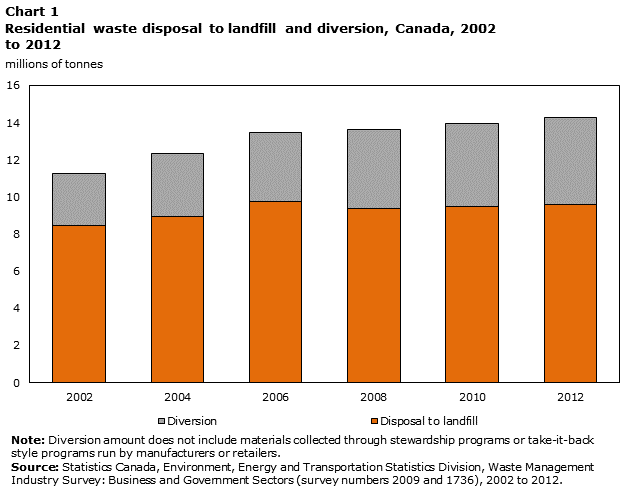
Description for Chart 1
| Disposal to landfill | Diversion | |
|---|---|---|
| tonnes | ||
| 2002 | 8,446,766 | 2,789,669 |
| 2004 | 8,961,583 | 3,363,803 |
| 2006 | 9,748,217 | 3,722,843 |
| 2008 | 9,350,354 | 4,300,979 |
| 2010 | 9,459,014 | 4,510,688 |
| 2012 | 9,586,511 | 4,664,396 |
| Note: Diversion amount does not include materials collected through stewardship programs or take-it-back style programs run by manufacturers or retailers. Source: Statistics Canada, Environment, Energy and Transportation Statistics Division, Waste Management Industry Survey: Business and Government Sectors (survey numbers 2009 and 1736), 2002 to 2012. |
||
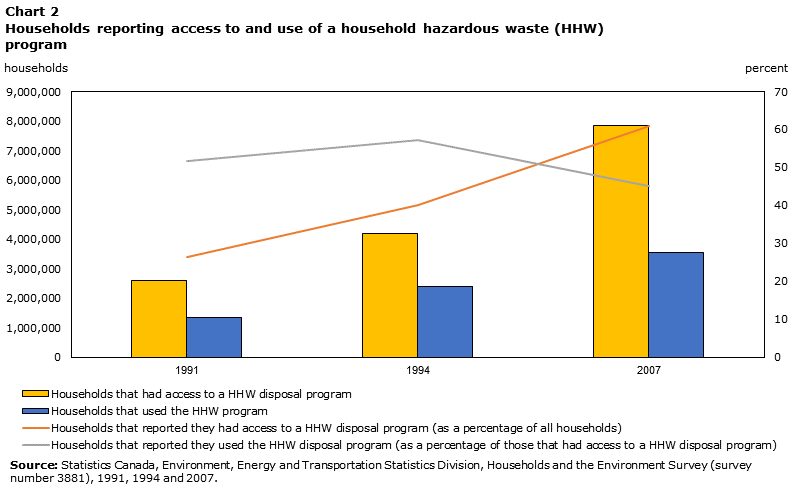
Description for Chart 2
| Households that reported they had access to a HHW disposal program (as a percentage of all households) | Households that reported they used the HHW disposal program (as a percentage of those that had access to a HHW disposal program) | Households that had access to a HHW disposal program | Households that used the HHW program | |
|---|---|---|---|---|
| percent | percent | households | households | |
| 1991 | 26.4 | 51.7 | 2,607,444 | 1,347,397 |
| 1994 | 40.2 | 57.1 | 4,174,000 | 2,383,000 |
| 2007 | 60.8 | 45 | 7,863,714 | 3,540,696 |
| Source: Statistics Canada, Environment, Energy and Transportation Statistics Division, Households and the Environment Survey (survey number 3881), 1991, 1994 and 2007. | ||||
Waste diversion by material type
While increasing economic development tends to lead to increasing rates of waste production,Note 1 the amount of residential waste sent for disposal to landfills or incinerators compared to diversion can be impacted by other factors. The availability of recycling programs to households and the scope of the materials included in these programs are among the principal factors impacting diversion. The increase in waste diverted from landfill over the years corresponds closely to the increase in the population that has access to these programs.
Although the data in Table 1 are drawn from both residential and non-residential sources, the influence of new waste diversion programs is evident when comparing the diversion of paper fibres with organic materials over the period 2002 to 2012. Paper recycling programs have been widely available in many parts of the country for more than two decades, compared to the relatively recent introduction of wide-scale organics recycling and associated green-bin programs. The change in the amount of diverted paper fibres between 2002 and 2012 is +8%, while the amount of organics diverted from landfill has increased by 87% over the same period.
Similarly, in 2008, just over 24,000 tonnes of e-waste were sent for diversion via programs administered by or for municipalities (Table 1); this had risen to just over 71,000 tonnes by 2012, as more programs were introduced during this time period to take back electronic products.
| 2002 | 2004 | 2006 | 2008 | 2010 | 2012 | |
|---|---|---|---|---|---|---|
| tonnes | ||||||
| Canada | 6,641,546 | 7,112,735 | 7,626,683 | 8,310,570 | 8,083,370 | 8,448,007 |
| All paper fibresNote 1 | 3,109,797 | 3,126,430 | 3,421,209 | 3,437,976 | 3,246,679 | 3,355,667 |
| Glass | 329,353 | 395,150 | 378,003 | 421,007 | 434,872 | 412,092 |
| Ferrous metals | 632,165 | 287,280 | 278,036 | 350,370 | 451,954 | 452,790 |
| Copper and aluminum | 41,583 | 49,476 | 51,225 | 58,950 | 76,935 | 80,318 |
| Mixed metals | 179,257 | 146,022 | 148,231 | 127,033 | 93,125 | 101,111 |
| White goodsNote 2, Note 3 | Note ..: not available for a specific reference period | 236,683 | 299,397 | 312,988 | 328,396 | 327,791 |
| ElectronicsNote 2 | Note ..: not available for a specific reference period | 10,245 | 11,357 | 24,367 | 51,105 | 71,396 |
| Plastics | 144,181 | 192,088 | 232,339 | 296,797 | 313,036 | 318,550 |
| TiresNote 2 | Note ..: not available for a specific reference period | 136,386 | 138,646 | 158,336 | 151,960 | 160,686 |
| Construction, renovation and demolition | 645,931 | 848,197 | 715,364 | 720,076 | 653,255 | 636,573 |
| Organics | 1,310,790 | 1,519,601 | 1,906,114 | 2,332,295 | 2,212,484 | 2,453,330 |
| Other materialsNote 4 | 248,491 | 165,180 | 46,763 | 70,375 | 69,569 | 77,703 |
.. not available for a specific reference period
Sources: Statistics Canada, CANSIM table 153-0043 (accessed February 16, 2016). Statistics Canada, Environment, Energy and Transportation Statistics Division, Waste Management Industry Survey: Business and Government Sectors (survey numbers 2009 and 1736), 2002 to 2012. |
||||||
Household waste management
Household waste often includes items that contain materials such as plastics, metals, glass and paper that can be recycled for future use as new products. Other waste materials may be compostable. A small portion of the waste generated by a household may be neither recyclable nor compostable, often ultimately ending up in a landfill or an incinerator.
Households also produce hazardous wastes that require special consideration when discarding. Items such as paint, solvents, pesticides and electronic goods may contain materials that, if released to the environment without adequate safeguards or treatment, can have harmful effects. For instance, toxic metals (e.g., mercury, lead, cadmium, and arsenic) and chemicals used in these products can be persistent substances that can accumulate in soils and groundwater, ultimately finding their way into living organisms. In many communities, programs that enable the diversion of hazardous materials from landfills are available.
e-Waste
Diverting unwanted electronics goods from landfills and incinerators prevents the release to the environment of toxic materials that are present in these goods. In addition, proper processing and removal of these materials allows for recovery and re-introduction into the manufacturing process, reducing the need for new raw material in the assembly of new products.
Advancements in technology usually contributes to the obsolescence and replacement of products. This is the case for certain types of consumer electronics such as cathode ray tube (CRT) televisions, video cassette recorders (VCRs), and older computers and cellular phones. The advent of high definition (HD) televisions and the phasing out of analog broadcast television in Canada in mid-2011Note 2 means that older televisions are being retired in favour of newer HD televisions that use flat screen technologies such as liquid crystal displays (LCDs), digital light projection (DLP), light-emitting diodes (LED) and plasma (Chart 3). This has also changed the devices connected to a television, such as cable and satellite receiver boxes and personal video recorders (PVRs). In a relatively short period of time, the number of analog devices, which typically do not support high definition video, has dropped, while the number of digital devices, which do support high definition video, has increased (Chart 4).

Description for Chart 3
| 2007 | 2011 | |
|---|---|---|
| percentage of households that used a television | ||
| CRT | 69 | 32 |
| HD tube | 11 | 13 |
| Projection | 5 | 3 |
| DLP | 2 | 2 |
| LCD | 15 | 36 |
| Plasma | 6 | 20 |
| LED | Note ..: not available for a specific reference period | 10 |
|
.. not available for a specific reference period Source: Statistics Canada, Environment, Energy and Transportation Statistics Division, Households and the Environment Survey (survey number 3881), 2007 and 2011. |
||
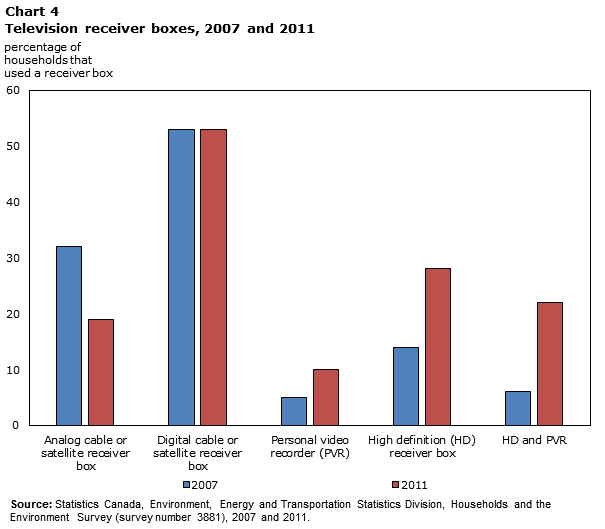
Description for Chart 4
| 2007 | 2011 | |
|---|---|---|
| percentage of households that used a receiver box | ||
| Analog cable or satellite receiver box | 32 | 19 |
| Digital cable or satellite receiver box | 53 | 53 |
| Personal video recorder (PVR) | 5 | 10 |
| High definition (HD) receiver box | 14 | 28 |
| HD and PVR | 6 | 22 |
|
Source: Statistics Canada, Environment, Energy and Transportation Statistics Division, Households and the Environment Survey (survey number 3881), 2007 and 2011. |
||
Televisions
One of the most common types of consumer electronics used by Canadian households is the television. The Households and the Environment Survey (HES) reveals that 99% of Canadian households used at least one in 2007 and 98% in 2011; of these, over 50% of households indicated owning 2 or more televisions (Chart 5). The changes in television technology described above have likely contributed to the fact that televisions were the most frequently reported type of e-waste by Canadian households. In 2013, 3.6 million households (26% of households in Canada) reported having at least one unwanted television. Fifty-four percent of these households reported that they disposed of televisions at an e-waste depot, while 19% donated or gave them away and 17% had not disposed of them at the time of the interview in 2013.
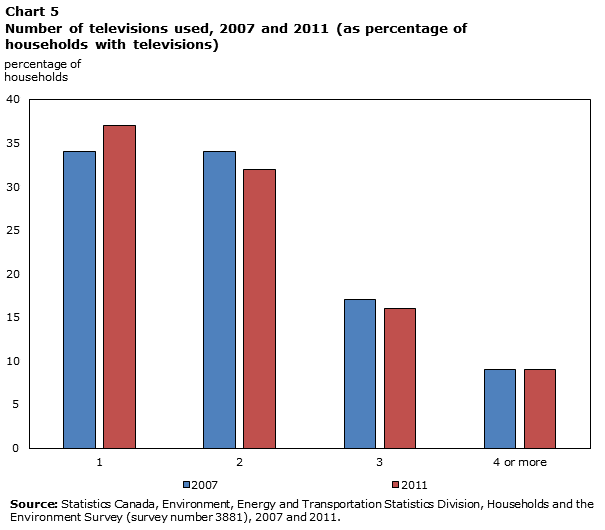
Description for Chart 5
| 2007 | 2011 | |
|---|---|---|
| percentage of households | ||
| 1 | 34 | 37 |
| 2 | 34 | 32 |
| 3 | 17 | 16 |
| 4 or more | 9 | 9 |
| Source: Statistics Canada, Environment, Energy and Transportation Statistics Division, Households and the Environment Survey (survey number 3881), 2007 and 2011. | ||
Video cassette recorders
Video cassette recorders (VCRs) were the first device allowing households to watch television on their own schedules, rent or purchase movies to watch at home and to easily watch home movies recorded with video cameras. Advancements in technology have seen the replacement of VCRs with Blu-ray/DVD players, personal video recorders (PVRs) and even a shift to on-demand video streaming, resulting in more households having VCRs they no longer want or need. This shift can be seen in the increase of use of PVRs and HD PVRs in Chart 4.
In 2007, there were approximately 10.4 million VCRs used by Canadian households. Four years later, the number of VCRs used by Canadian households had dropped to about 5.4 million, meaning about 5 million VCRs needed to be disposed of during that time. In 2011 and 2013, about half of the households that had unwanted audio visual equipment (which includes VCRs, DVD players, speakers and portable digital music players) reported they took the unwanted items to a depot or drop-off centre.
Computers
In 2007, the HES estimated that 9.4 million households (73% of all households in Canada) used at least one computer (Chart 6). This increased to 78% of all households in 2011. In addition to more households using a computer from 2007 to 2011, the number of households that used more than one computer also increased from 3.3 million to 5.6 million, which is a 68% increase over the four years.
In 2013, 3.4 million households (24% of all households) reported having an unwanted computer. The most commonly reported method of disposal was sending them to a depot or drop-off centre, which was reported by 53% of these households. Donating them or giving them away was reported by 15% of households. A few households (3% of households that had an unwanted computer) reported putting them in the garbage. About a quarter of households that had an unwanted computer (24%) still had them when they were interviewed in 2013.

Description for Chart 6
| Used one computer | Used more than one computer | |
|---|---|---|
| percentage of households | ||
| 2007 | 47 | 26 |
| 2011 | 37 | 41 |
| Source: Statistics Canada, Environment, Energy and Transportation Statistics Division, Households and the Environment Survey (survey number 3881), 2007 and 2011. | ||
Cellular phones
In 2013, 84.9% of households in Canada had at least one cell phone, and for some households this was the only type of phone they had.Note 3 Advances in cell phone technology often result in their replacement after only eighteen months.Note 4
The HES asked Canadian households whether they had an unwanted cell phone in the previous year and if this was the case, how they had disposed of it. In 2011, about 2.4 million households had at least one unwanted cell phone in the previous year, which equates to 18% of all households. This climbed by 21% to 2.9 million households in 2013.Note 5
While many households used a disposal method such as taking or sending them to a depot (24% of households that had an unwanted cell phone in 2013) or returning them to the retailer/supplier (18%), about 5% of households that had an unwanted cell phone disposed of it in the garbage, which equated to about 154,000 households in 2013. About 1.27 million households, or 44% of households that had an unwanted cell phone, still had them when they were interviewed in 2013 (Chart 7).
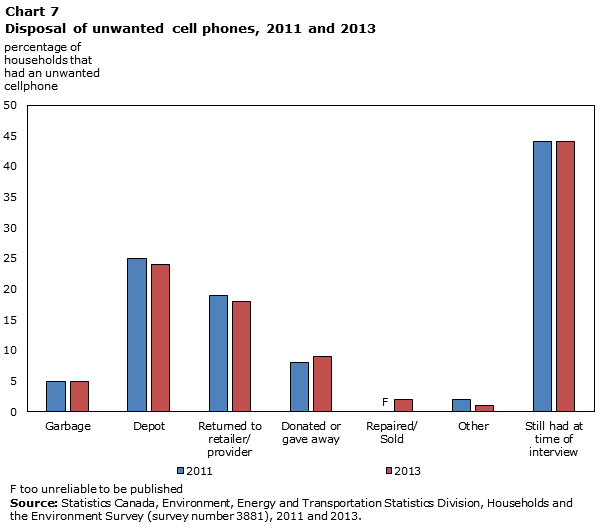
Description for Chart 7
| 2011 | 2013 | |
|---|---|---|
| percentage of households that had an unwanted cellphone | ||
| Garbage | 5 | 5 |
| Depot | 25 | 24 |
| Returned to retailer/provider | 19 | 18 |
| Donated or gave away | 8 | 9 |
| Repaired/Sold | Note F: too unreliable to be published | 2 |
| Other | 2 | 1 |
| Still had at time of interview | 44 | 44 |
|
F too unreliable to be published Source: Statistics Canada, Environment, Energy and Transportation Statistics Division, Households and the Environment Survey (survey number 3881), 2011 and 2013. |
||
Conclusion
This article demonstrates that reducing and redirecting residential waste from landfill has increased markedly over the years. Ease of access to diversion programs seems to be a driver for these changes, as the increase in the presence of curbside and take-it-back programs has coincided with increased amounts of diverted waste processed by waste management facilities. Programs run by retailers also provide an important option in the area of e-waste such as cell phones.
Notes
- Date modified:

